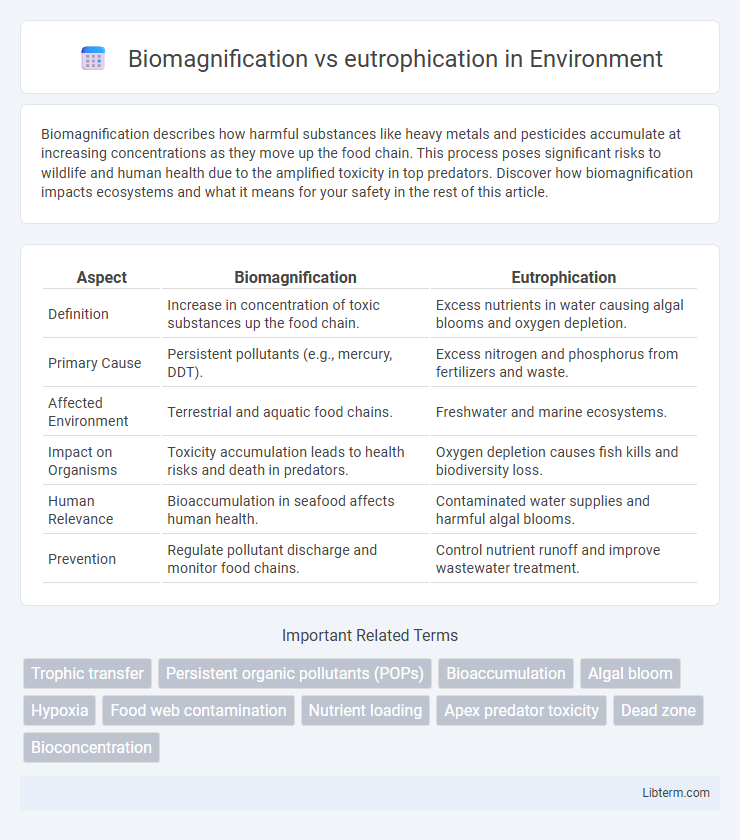Biomagnification describes how harmful substances like heavy metals and pesticides accumulate at increasing concentrations as they move up the food chain. This process poses significant risks to wildlife and human health due to the amplified toxicity in top predators. Discover how biomagnification impacts ecosystems and what it means for your safety in the rest of this article.
Table of Comparison
| Aspect | Biomagnification | Eutrophication |
|---|---|---|
| Definition | Increase in concentration of toxic substances up the food chain. | Excess nutrients in water causing algal blooms and oxygen depletion. |
| Primary Cause | Persistent pollutants (e.g., mercury, DDT). | Excess nitrogen and phosphorus from fertilizers and waste. |
| Affected Environment | Terrestrial and aquatic food chains. | Freshwater and marine ecosystems. |
| Impact on Organisms | Toxicity accumulation leads to health risks and death in predators. | Oxygen depletion causes fish kills and biodiversity loss. |
| Human Relevance | Bioaccumulation in seafood affects human health. | Contaminated water supplies and harmful algal blooms. |
| Prevention | Regulate pollutant discharge and monitor food chains. | Control nutrient runoff and improve wastewater treatment. |
Introduction to Biomagnification and Eutrophication
Biomagnification refers to the progressive increase in the concentration of toxic substances, such as heavy metals or pesticides, in organisms at higher trophic levels within a food chain. Eutrophication is the process by which water bodies become enriched with nutrients, primarily nitrogen and phosphorus, leading to excessive algal growth and oxygen depletion. Both phenomena significantly impact aquatic ecosystems, with biomagnification primarily affecting organism health and eutrophication causing habitat degradation and biodiversity loss.
Defining Biomagnification
Biomagnification refers to the progressive increase in the concentration of toxic substances, such as heavy metals or persistent organic pollutants, as they move up through successive trophic levels in a food chain. These pollutants accumulate in organisms' tissues, becoming more concentrated in predators at higher trophic levels, posing significant health risks to wildlife and humans. Unlike eutrophication, which involves nutrient over-enrichment leading to algal blooms and oxygen depletion in aquatic ecosystems, biomagnification centers on the amplification of harmful chemicals through biological consumption.
Understanding Eutrophication
Eutrophication is the enrichment of water bodies with nutrients, primarily nitrogen and phosphorus, leading to excessive algal blooms that deplete oxygen levels and harm aquatic life. This process disrupts aquatic ecosystems by causing hypoxia, resulting in fish kills and loss of biodiversity. Unlike biomagnification, which involves the accumulation of toxins up the food chain, eutrophication is driven by nutrient pollution from agricultural runoff, wastewater discharge, and industrial effluents.
Key Differences Between Biomagnification and Eutrophication
Biomagnification refers to the increasing concentration of toxic substances, such as heavy metals or pesticides, in organisms at higher trophic levels of a food chain, posing risks to wildlife and humans. Eutrophication is the nutrient enrichment of water bodies, primarily from nitrogen and phosphorus, leading to excessive algal growth, oxygen depletion, and harmful effects on aquatic ecosystems. The key difference lies in biomagnification being a chemical accumulation process affecting organism health across trophic levels, while eutrophication is an ecological process causing habitat degradation due to nutrient overload.
Causes and Sources of Biomagnification
Biomagnification occurs when toxic substances like heavy metals, pesticides, and persistent organic pollutants accumulate in organisms at increasing concentrations along the food chain. Primary sources include industrial discharges, agricultural runoff, and improper waste disposal, which introduce these contaminants into aquatic and terrestrial ecosystems. This process poses significant ecological and health risks by concentrating harmful chemicals in top predators, including humans.
Major Triggers of Eutrophication
Eutrophication is primarily triggered by the excessive input of nutrients such as nitrogen and phosphorus from agricultural runoff, sewage discharge, and industrial waste, which stimulate rapid algal growth and disrupt aquatic ecosystems. Biomagnification involves the increasing concentration of toxic substances like heavy metals and persistent organic pollutants up the food chain, affecting top predators but is not a direct cause of eutrophication. The major triggers of eutrophication create nutrient imbalances that lead to oxygen depletion and loss of biodiversity in water bodies.
Ecological Impacts of Biomagnification
Biomagnification leads to the accumulation of toxic substances such as heavy metals and persistent organic pollutants in higher trophic levels, causing severe physiological and reproductive harm to predators. This process disrupts food webs by reducing population sizes and biodiversity, jeopardizing ecosystem stability. In contrast to eutrophication's nutrient overload effects, biomagnification specifically impacts species through contaminant concentration increases along the trophic chain.
Environmental Consequences of Eutrophication
Eutrophication causes excessive nutrient enrichment in water bodies, leading to dense algal blooms that deplete oxygen and create hypoxic conditions, severely harming aquatic life. This process disrupts aquatic ecosystems, reduces biodiversity, and can result in fish kills and loss of habitat for sensitive species. Unlike biomagnification, which involves toxin accumulation through food chains, eutrophication primarily affects water quality and ecosystem health through nutrient overload.
Prevention and Control Strategies
Preventing biomagnification involves reducing the release of persistent organic pollutants and heavy metals into ecosystems through strict regulation of industrial discharge and promoting the use of safer chemical alternatives. Controlling eutrophication requires limiting nutrient runoff by implementing agricultural best management practices such as buffer strips, controlled fertilizer application, and upgrading wastewater treatment plants to reduce nitrogen and phosphorus inputs. Monitoring water quality and restoring wetlands play critical roles in mitigating both biomagnification and eutrophication by enhancing natural filtration and ecosystem resilience.
Conclusion: The Importance of Addressing Both Issues
Addressing both biomagnification and eutrophication is crucial for maintaining ecosystem health and biodiversity. Biomagnification leads to toxic substance accumulation in food chains, while eutrophication causes oxygen depletion and habitat loss in aquatic systems. Integrated management strategies targeting pollution reduction and nutrient control are essential to mitigate these interconnected environmental threats.
Biomagnification Infographic

 libterm.com
libterm.com